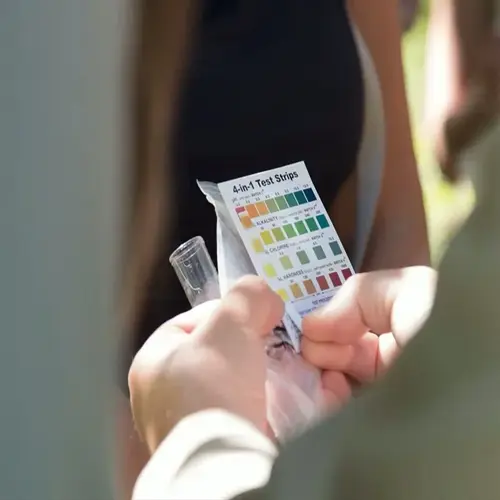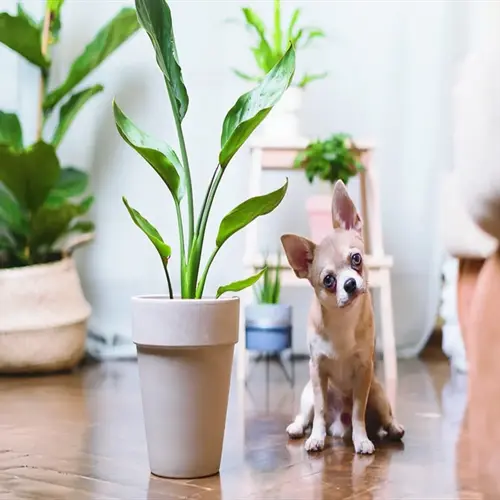Understanding Bird Feather Plucking: Causes and Solutions

Written by
David Smith
Reviewed by
Prof. David Walsh, Ph.D.Plucking of feathers in birds primarily results from behavioral triggers, such as chronic stress.
The early detection of these behaviors includes observations of feather damage or non-normative social withdrawal.
Environmental hazards include exposure to harmful chemicals in cleaning supplies and exposure to prolonged or irregular light cycles.
The major interventions address nutritional deficiencies, social isolation, and hormonal imbalances directly.
Prevention will involve daily interaction and monthly vigilance around the bird's environment to evaluate risk with veterinarians.
The long-standing myth of supplements resolving the problem alone in chronic plucking is simply that- a myth.
Article Navigation
The act of feather plucking in birds occurs when birds pull their own feathers out of their body. This behavior is alarming to bird owners. Species such as parrots, cockatoos, and African greys are at a higher risk for feather plucking behavior. Early identification of bald patches is important.
Feather loss harms health. Birds struggle to stay warm. They become vulnerable to infections. Their social interactions suffer, too. This problem demands immediate attention.
We will explore causes such as stress or a poor diet. Practical solutions follow. We also debunk myths about this condition. Understanding helps you support your bird.
Understanding Feather Plucking
The clinical term for feather pulling is feather destructive behavior. It mostly affects parrots with over 30 percent displaying some symptoms. Cockatoos and African greys follow at a short distance. This behavior is quite different from normal grooming activity.
Normal preening occurs for only a few minutes. Your bird will groom its feathers in a matter of seconds. However, plucking can last for hours, and you may observe your bird continually pulling in one area. This difference can make it easier to identify a plucking issue.
The entire recovery process for feathers takes 6-12 months. If you have damaged follicles, that will complicate regrowth. The longer you wait, the worse it will become. Without treatment, you will develop permanent bald patches. Taking action early will help reduce irreversible problems. The fact that it may take up to a year emphasizes the need for a quick response.
I have treated one African grey with baldness on the chest. The owner thought this was normal molting. In fact, a chronic stress state was responsible for the poking. Observing proper cage location, the symptoms disappeared within several weeks. It is wonderful how observation will help.
Early Warning Signs
Physical signs appear weeks before feather loss is evident. Daily examination of the chest, wings, and back may show a condition that can be treated, for instance, the finding of gnawed feathers on the cage bottom. Broken quills indicate nibbling. Redness of the skin is evident at plucking sites. Prompt action can prevent an escalation of the condition.
Changes in behavior indicate trouble. Parrots stop talking when under stress. Your bird suddenly refuses to be handled. Scratching movements increase in certain areas. Normal calm is replaced by restlessness. Vocal species stop talking. These changes require immediate attention, or your feathered friends will disappear.
I remember a cockatoo client, Mango. His owner noticed constant wing grooming two months before the bald patches appeared. We discovered that the anxiety causing this was due to exposure to drafts. Changing the position of his aviary solved the plucking problem. Timely action saved the feathering.
Track grooming time. Regular sessions last a few minutes, but undue plucking lasts more than 30 minutes many times a day. In grooming, birds focus on the feather bases, not the tips. After grooming, the skin appears irritated. Document these incidents weekly.
Feather Damage
- Physical Evidence: Broken shafts or chewed feathers around cage bottom
- Progression: Starts with down feathers before moving to flight feathers
- Location Focus: Often concentrated on chest, wings, or back areas
Behavioral Shifts
- Social Changes: Increased aggression or avoidance during handling
- Activity Level: Restlessness with frequent scratching motions
- Vocal Patterns: Unusual silence or distress calls in vocal species
Grooming Patterns
- Duration: Sessions lasting over 30 minutes multiple times daily
- Intensity: Focused nibbling at feather bases rather than tips
- Aftermath: Visible skin redness or irritation after sessions
Appetite Changes
- Food Behavior: Selective eating or tossing previously loved foods
- Water Intake: Increased drinking due to stress response
- Weight Fluctuation: Noticeable weight loss in 2-3 weeks
Sleep Disturbances
- Night Activity: Unusual nighttime movements or vocalizations
- Daytime Lethargy: Excessive napping outside normal rest periods
- Sleep Position: Changes in preferred sleeping posture
Common Environmental Triggers
Your bird is exposed to household triggers every day. Chemical cleaners emit toxic fumes that put respiratory stress on them. Loud appliances such as blenders create noise pollution. Drafts from windows or AC vents disrupt normal body temperature. Mitigation ranges from easy to hard and requires certain actions.
Switch to vinegar-water (and similar) solutions for ease of problem fixes with animals. Move cages far away from kitchens so that they do not receive fume medication of medium difficulty. Social stresses, such as introducing new pets, require strict behavioral changes. Parrots are more sensitive to these changes than finches. Their sensitive conditions require more care.
I supported a client with a macaw that plucked its feathers in an area of a noisy corridor. We created a quiet corner and placed sound-deadening panels. Switched cleaners to natural-based. In a matter of weeks, the bird stopped plucking its feathers. Sometimes the simple changes yield the biggest results.
External stimuli include street traffic and construction noise. White noise machines are a great alternative. Blackout curtains for control of light are helpful. Placement of cages is of extreme importance. Avoid high-traffic areas. Provide the animal with visual barriers for security. These changes will ease the stress of an animal being in a generated environment.
Core Causes and Solutions
Stress leads to feather plucking in stressful birds like parrots. Create quiet areas and cover cages for relief. Continue the same feeding schedule. Use avian pheromones. Treat the cause, not the symptoms. There are no temporary cures without knowing the reason.
Nutritional deficiencies lead to plucking. As African greys have additional calcium needs, start switching to fortified pellets slowly. Add some chopped kale or spinach to their diet each day. Consult your avian veterinarian regarding calcium or other supplements. Diets that are formulated for species-specific needs help prevent deficiencies that cause destructive feather plucking.
Social isolation has extremely negative effects on the behavior of cockatoos. Provide at least two hours of interactive playtime every day. Take time selecting compatible companions. Leave foraging toys out when you're away. These are all medium-difficulty methods of re-establishing confidence and managing plucking behavior.
Skin irritation is best resolved by addressing your environment. Swap out chemical-based cleaners with vinegar solution cleaners. Use paper cage liners instead of dusty bedding. Use air purifiers near the cages. Implementing these practical changes removes allergens that cause discomfort and damage feathers.
Stress and Anxiety
- Cause: Loud environments or sudden routine changes
- Solution 1: Create quiet zones with covered cages
- Solution 2: Maintain consistent daily schedules
- Solution 3: Use avian-safe pheromone diffusers
Nutritional Deficiencies
- Cause: Lack of vitamin A, calcium or amino acids
- Solution 1: Introduce fortified pellets gradually
- Solution 2: Add chopped dark leafy greens daily
- Solution 3: Consult vet for supplement protocols
Social Isolation
- Cause: Insufficient interaction or lone housing
- Solution 1: Minimum 2 hours daily interactive play
- Solution 2: Consider compatible companion birds
- Solution 3: Use foraging toys during absences
Skin Irritations
- Cause: Allergens from bedding or cleaning products
- Solution 1: Switch to paper-based cage liners
- Solution 2: Use vinegar-water for cage cleaning
- Solution 3: Install air purifiers nearby
Hormonal Imbalances
- Cause: Breeding season fluctuations
- Solution 1: Reduce daylight exposure to 10-12 hours
- Solution 2: Remove nesting materials/boxes
- Solution 3: Avoid petting back or wings
Prevention and Long-Term Care
Daily attention is the best way to deter your bird from pulling its feathers out. Give your pet two hours of your time each day. Parrots must also have puzzle toys to stimulate the mind. Water and food should be fresh each day. Watch for signs of stress, such as damaged feathers. Routines will help your bird feel secure.
Maintain health through monthly actions. Young ones need vet checks every 6 months. Older birds require blood work annually. Perches should be inspected for wear. Toys should be changed every week. Cockatoos thrive on new foraging explorations monthly. Record weight every 3 days.
Bonding varies by species. Teach African greys new commands Quarterly. Let finches have a bath together twice each week. Change cages when wings touch sides. Expand the annual habitat. I enlarged a client's macaw cage when I observed feather stress. Feather condition improved greatly.
Annual planning includes veterinary consultations and environmental assessments. Birds under five years old require a yearly check-up, while birds over ten years old should undergo biannual veterinary visits. Replace any worn-out accessories. Make plans for how you will take care of your birds in the future. Prevention fosters lifelong feather health.
Daily Care Essentials
- Interaction: Minimum 2 hours supervised out-of-cage time
- Diet Check: Fresh water changes and varied food offerings
- Stress Scan: Monitor for feather damage or behavior changes
- Enrichment: Rotate toys and introduce new foraging puzzles
Weekly Maintenance
- Cage Cleaning: Full disinfection with bird-safe solutions
- Toy Rotation: Swap 50% of cage accessories weekly
- Weight Tracking: Record measurements every 3 days
- Bathing: Offer mist sprays or shallow water bowls 3 times
Monthly Assessments
- Feather Inspection: Document regrowth patterns monthly
- Habitat Audit: Check perches, lighting, and safety hazards
- Diet Review: Adjust portions based on seasonal activity
- Vet Prep: Update health logs for upcoming consultations
Biannual Checkpoints
- Vet Visits: Comprehensive exams including blood work
- Habitat Upgrades: Evaluate cage size and accessories
- Diet Optimization: Nutritional analysis with avian specialist
- Behavior Logs: Review 6-month patterns for improvements
Long-Term Bonding
- Training Goals: Teach new commands quarterly
- Socialization: Gradual introductions to trusted guests
- Environmental Enrichment: Annual outdoor aviary upgrades
- Legacy Planning: Identify future caregivers if needed
5 Common Myths
Many owners mistakenly believe feather plucking always indicates serious physical illness or disease in birds.
While medical issues can contribute, feather plucking is primarily behavioral in origin, often triggered by stress, boredom, or environmental factors. Many healthy birds develop this habit without underlying disease, though veterinary assessment remains essential to rule out infections or nutritional deficiencies.
Only neglected or abused birds pluck their feathers.
Feather plucking affects birds across all care levels, including those in loving homes with attentive owners. Genetic predisposition, species-specific sensitivities (common in parrots), and temporary stressors like routine changes can trigger this behavior regardless of the quality of care provided daily.
Feathers regrow quickly after plucking stops, so usually it is not a problem.
The regrowth of feathers requires 6-12 months for complete recovery, and repeated plucking can cause permanent damage to feathers and follicles. Cases of chronic feather picking lead often to skin infections, inability to maintain thermal regulation, and physiological pain, making immediate intervention necessary to prevent irreversible physical and mental changes.
Adding supplements to a bird's diet will cure feather chewing.
While nutritional lacks contribute, the addition of the substance is rarely of any avail until the basic causes such as environment, heredity, and sociality are adjusted for. Injury is often caused by over-supplementation of the basic food substances and toxins developed. Chemical and phototherapy are given instead to remedy the condition by a more environmental field, concentrating solely on the basic dietary needs instead of the temperamental side.
Young birds will outgrow feather plucking when they mature.
Juvenile birds do not naturally outgrow this problem, but rather they usually get worse unless help is obtained. Therefore, specially trained avian specialists must intervene with professional behavior modification since the habit of plucking feathers remains neurologically ingrained. Structured retraining and proper environmental manipulations are necessary for their resolution.
Conclusion
Bird feather plucking can be controlled with daily commitment. Appropriate routines can effectively reduce the triggers associated with plucking, and once noticed early enough, treatment for plucking can eliminate the behavior before feathers incur permanent damage. Contact your veterinarian at the first sign of any issue. They will provide guidance related to your particular bird's needs.
You manage both the environment and the bonding process. Monitor noise levels and exposure to chemicals. Create schedules to ensure interactions are conducted safely. Parrots require daily engagement from people. Finches require the companionship of others in the flock. Your engagement provides a sense of safety, which lessens the chances of undesirable behavior.
Healing requires commitment. I have seen birds without their feathers, and they replace them. One cockatoo took six months to become feathered with a change in environment. Another bird ceased pulling feathers during scheduled games. Effort means feather replacement is possible. Apply your efforts now for visible results.
External Sources
Frequently Asked Questions
How is feather plucking treated in birds?
Treatment requires addressing root causes through veterinary guidance:
- Behavioral modifications like environmental enrichment and routine consistency
- Diet adjustments to correct nutritional deficiencies
- Medical intervention for infections or hormonal imbalances
- Stress reduction techniques including safe spaces and pheromone diffusers
Is feather plucking painful for birds?
Yes, chronic feather plucking causes significant discomfort through:
- Exposed skin becoming vulnerable to infections and temperature sensitivity
- Follicle damage leading to permanent feather loss areas
- Psychological distress manifesting as aggression or social withdrawal
- Potential bleeding if plucking damages blood feathers
How can I differentiate normal preening from harmful plucking?
Key differences include duration, physical evidence, and bird behavior:
- Preening lasts minutes while plucking sessions exceed 30 minutes
- Plucking leaves broken feathers and bald patches unlike preening
- Plucking birds show agitation versus relaxed posture during preening
- Plucking often targets specific body areas like chest or wings
What environmental triggers cause feather plucking?
Common household triggers include:
- Chemical pollutants from cleaners or scented products
- Inconsistent light exposure disrupting sleep cycles
- Loud noises causing chronic stress responses
- Social stressors like isolation or overcrowding
- Temperature fluctuations from drafts or heating vents
Can nutritional supplements stop feather plucking?
Supplements alone rarely resolve plucking as it's primarily behavioral. While correcting deficiencies helps, effective solutions require comprehensive approaches including environmental adjustments, veterinary behavior plans, and addressing psychological triggers through enrichment activities and social interaction improvements.
What are early warning signs of feather plucking?
Early indicators include:
- Finding chewed feathers at cage bottom
- Increased scratching motions targeting specific body areas
- Uncharacteristic silence in normally vocal birds
- Avoidance of handling or sudden aggression
- Changes in eating or sleeping patterns
Do young birds outgrow feather plucking habits?
No, juvenile birds don't naturally outgrow this behavior. Without intervention, plucking typically worsens as habits become neurologically ingrained. Professional behavior modification is essential early on to prevent permanent follicle damage and chronic psychological distress requiring long-term management strategies.
How important is cage location for prevention?
Optimal cage placement is critical for reducing triggers:
- Avoid high-traffic areas causing constant disturbance
- Prevent exposure to kitchen fumes or direct sunlight
- Ensure visual security with partial covering options
- Maintain stable temperatures away from vents/windows
- Balance social interaction with quiet retreat access
Are certain bird species more prone to feather plucking?
Yes, species variations exist with higher susceptibility in:
- Parrots (especially African greys and cockatoos)
- Macaws exhibiting stress-related plucking
- Cockatiels during hormonal fluctuations
- Larger parrots versus smaller finch species
- Birds with previous trauma or rehoming history
Can feather plucking be completely cured?
While manageable with dedicated care, complete reversal depends on early intervention before follicle damage. Success requires consistent implementation of veterinary-approved behavior plans, environmental optimization, and owner commitment to addressing both physical and psychological triggers throughout the bird's lifetime.

